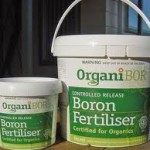Wally Richards – the importance of Boron
Boron deficiency has been recognised as one of the most common micro nutrient problems in agriculture with large areas of the world (including NZ) being boron deficient.
The following explains how Boron is vital to your gardens.
Boron is a semi-metallic trace element which is essential for plant growth and the availability of this micro nutrient in the soil and irrigation water is an important determinant of crop yield and quality. Boron does not appear on Earth in its elemental form but is typically found as boric acid or as borate (boron oxide) minerals. In these forms, boron is widely distributed in nature and is released into the environment (soil, water, air) mainly via geothermal activity and the natural weathering of clay-rich sedimentary rocks.
Boron deficiencies can be corrected with the use of borate fertilizers and in areas of acute deficiency borates can increase crop yields by 30 to 40 percent. However, the management of boron concentrations in soils can be difficult as a narrow range exists between plant deficiency and toxicity.
Traditionally, the most commonly used boron fertilizers are sodium borates (eg borax, ulexite) and they range from 11.3 to 20.5 % boron. However, due to the high solubility of sodium borates it is difficult to maintain consistent boron concentrations in soil. Thus, sodium borate fertilizers are typically applied frequently and in small quantities to avoid boron toxicity.
A new prod
 uct; OrganiBOR® is a naturally occurring borate mineral (hydroboracite) mined in the Santa Rosa de Los Pastos Grandes valley in Argentina and is made up of a rare mixture of magnesium and calcium borate. Unlike, sodium borates, hydroboracite is not highly soluble and therefore OrganiBOR® releases boron slowly into the soil, at a rate similar to which most plants uptake boron.
uct; OrganiBOR® is a naturally occurring borate mineral (hydroboracite) mined in the Santa Rosa de Los Pastos Grandes valley in Argentina and is made up of a rare mixture of magnesium and calcium borate. Unlike, sodium borates, hydroboracite is not highly soluble and therefore OrganiBOR® releases boron slowly into the soil, at a rate similar to which most plants uptake boron.
OrganiBOR® can, therefore be applied in larger quantities than traditional boron fertilizers and will persist in the soil without the risk of boron toxicity. One application of OrganiBOR® will last anywhere between 3 and 10 years depending on the crop, soil type and climatic conditions. Thus application of OrganiBOR® is simpler for most growers and gardeners and more cost effective, especially when combined with soil and foliage testing to determine exactly when the next application is required. OrganiBOR® is certified for organic use and is suitable for grapes, apples, kiwifruit, avocados, potatoes, tomatoes and almost all other crops grown commercially or in home gardens in New Zealand.
As OrganiBOR® releases boron into in the soil it combines with water and forms boric acid and plants take up boron from the soil in this form. Boron plays an essential role in a plant’s life cycle. In vascular plants, boron deficiency inhibits leaf expansion, root elongation, apical dominance, flower development, pollen tube growth and, in turn, fruit and seed set. Boron toxicity also results reduced shoot and root growth, with marginal and tip chlorosis and necrosis typically occurring.
While the effects of boron deficiency and toxicity are well documented, the biological mechanisms involving boron which lead to these symptoms are not well understood. Recently, it was shown that boron cross-links pectins in plant cell walls a process that is essential for cell wall synthesis, structure and function. But in addition to this, boron involvement has been implicated in a diverse range of cellular processes including regulation of gene expression, nucleic acid metabolism, carbohydrate and protein metabolism, indole acetic acid metabolism, membrane integrity and function, phenol metabolism, nitrogen fixation and nitrogen assimilation.
Accumulating evidence also points to boron being important to animals and humans. Boron has been shown to be necessary to complete the life cycles of some higher animals (eg zebra fish and frogs) and boron deprivation has been linked to impaired growth, bone health, brain function and immune response various animal models including humans.
The recent release of OrganiBOR® to the home garden market in one kilo gram containers through garden centres will allow gardeners to safely apply this essential element to the crops. It is applied at the rate of 100 grams per ten square metres which means the 1kg container will do 100 square metres for a 3 to 5 year treatment before the need to apply again.
This will be an absolute boom for home or part time growers that in the past have not been able to easily apply boron, unless they really know their stuff. Sprinkle it about every 3-5 years and forget about it in the knowledge that the plants will be getting the correct amount of boron without risking any sort of toxicity. The boron is of course taken up by the plants and distributed into the fruit or vegetables (or flowers for that matter) which are of course in turn eaten by you and me, so not only will your plants be healthier but you will be too.
Ask your local garden centre for the product.
Fertilisers can lock up in the soil for several reasons and when this happens plant growth is very slow as they are not getting the food to enable them to grow. Drenching the soil with Magic Botanic Liquid (MBL) will help release locked up soils and get things moving again. Sometimes the locking up can be as a result of some element missing that is vital. It can be a lack of Boron which you only need a small amount of to crank up the growth. Thus a slow release Boron that is only applied every few years is ideal for the home gardener.

